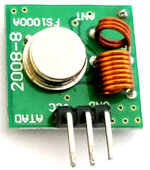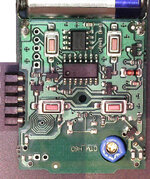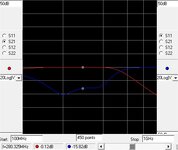pabloortiz132
Newbie level 5

- Joined
- Jun 29, 2023
- Messages
- 8
- Helped
- 0
- Reputation
- 0
- Reaction score
- 0
- Trophy points
- 1
- Location
- Badalona, Spain
- Activity points
- 98
Hello,
I have 3 garage remotes, so I have recently started trying to create a single remote that can operate all 3 garage doors.
I have been using SDR to read the codes that they are emitting, and, using an arduino and a cheap 433Mhz transmitter module, I have achieved to replicate all codes to an acceptable degree of precision.
Both the remotes and my cheap module use ASK modulation.
I have also figured out the frequencies at which both the remotes, and my cheap transmitter module operate. The issue is that they are all different.
One of the remotes operates at 280Mhz, another at 433.92MHz, and another at 433.95Mhz. The cheap module operates at 433.6Mhz.
I am clueless as to how i could modify the cheap transmitter to emit at 280Mhz, or 433.9Mhz, or how to create my own circuit. I have looked into PLL's but the ones that can operate from 280-434Mhz are quite expensive. So I am currently trying to use an FPGA to generate the carrier waves (Tang Nano 9K).
The cheap module uses a SAW resonator, and an inductor to increase the efficiency of the antenna.
There are no 280Mhz SAW resonators on the market.
Apparently the 433Mhz SAW resonators that are available, resonate at 433.9Mhz, so that also raises the question of why my module is emitting at 433.6Mhz: could I modify the circuit to adjust it to 433.9mhz? I will buy a few more modules from another provider who claims them to be 433.92mhz to test this.
I have opened the 280Mhz remote, and it seems to be using an RC resonator circuit, with the resistor being a potentiometer, adjusted to produce 280Mhz, could an RC resonator resonate this fast? In that case i could try to replicate this, but I am quite sure an RC resonator wouldnt work for 433.9mhz so I would still have to figure that out.
So the question is, is the FPGA the right call, or is there a much cheaper way i could accomplish my goal?
Also, if you know a book I could read to get started on resonators and AM transmitters, I welcome any recommendation.
I attach:
- Picture of my cheap transmitter module
- Front and Rear pictures of the 280Mhz (adjustable) remote
I have 3 garage remotes, so I have recently started trying to create a single remote that can operate all 3 garage doors.
I have been using SDR to read the codes that they are emitting, and, using an arduino and a cheap 433Mhz transmitter module, I have achieved to replicate all codes to an acceptable degree of precision.
Both the remotes and my cheap module use ASK modulation.
I have also figured out the frequencies at which both the remotes, and my cheap transmitter module operate. The issue is that they are all different.
One of the remotes operates at 280Mhz, another at 433.92MHz, and another at 433.95Mhz. The cheap module operates at 433.6Mhz.
I am clueless as to how i could modify the cheap transmitter to emit at 280Mhz, or 433.9Mhz, or how to create my own circuit. I have looked into PLL's but the ones that can operate from 280-434Mhz are quite expensive. So I am currently trying to use an FPGA to generate the carrier waves (Tang Nano 9K).
The cheap module uses a SAW resonator, and an inductor to increase the efficiency of the antenna.
There are no 280Mhz SAW resonators on the market.
Apparently the 433Mhz SAW resonators that are available, resonate at 433.9Mhz, so that also raises the question of why my module is emitting at 433.6Mhz: could I modify the circuit to adjust it to 433.9mhz? I will buy a few more modules from another provider who claims them to be 433.92mhz to test this.
I have opened the 280Mhz remote, and it seems to be using an RC resonator circuit, with the resistor being a potentiometer, adjusted to produce 280Mhz, could an RC resonator resonate this fast? In that case i could try to replicate this, but I am quite sure an RC resonator wouldnt work for 433.9mhz so I would still have to figure that out.
So the question is, is the FPGA the right call, or is there a much cheaper way i could accomplish my goal?
Also, if you know a book I could read to get started on resonators and AM transmitters, I welcome any recommendation.
I attach:
- Picture of my cheap transmitter module
- Front and Rear pictures of the 280Mhz (adjustable) remote





